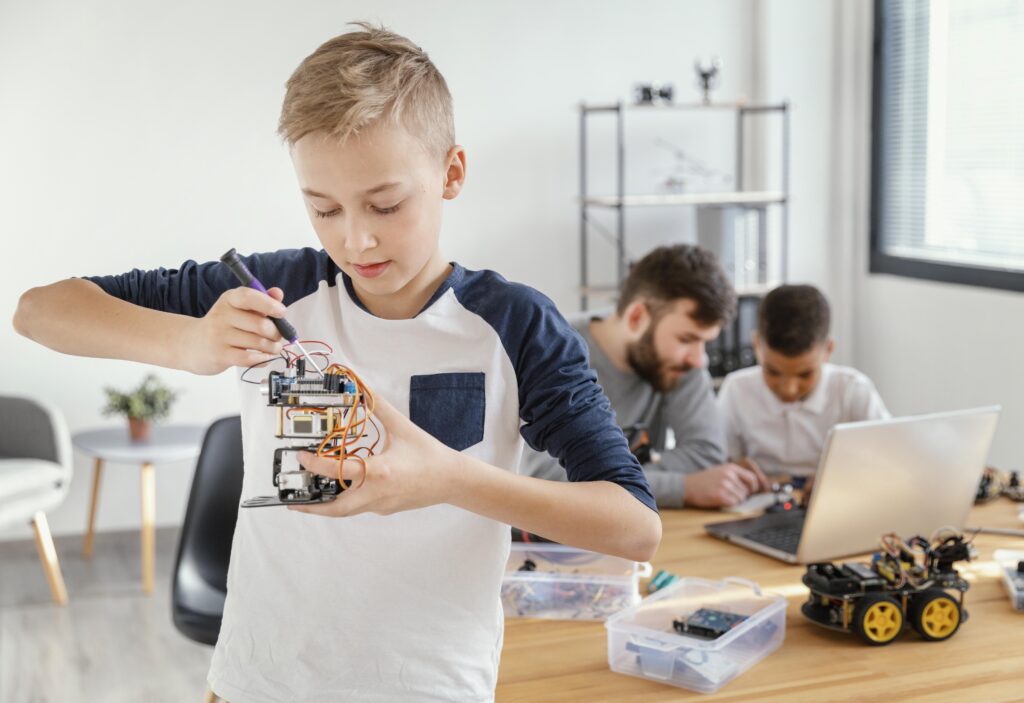In an era dominated by technological advancements, the integration of robotics in education has emerged as a captivating avenue for students to learn and thrive. Robotics isn’t just about assembling mechanical parts. It’s a dynamic field that fosters creativity, problem-solving skills, and a deep understanding of the science and technology shaping our world.
So, why should students consider robotics? Let’s delve into the exciting realm where innovation, education, and fun converge.
Real-World Applications: Beyond the Classroom
The impact of robotics extends far beyond the controlled environment of a classroom, seeping into the very fabric of our daily lives. As students delve into robotics, they gain insights into several real-world applications, becoming architects of the technological landscape that awaits them.
Agriculture and Precision Farming
In agriculture, robotics is transforming traditional farming practices. In many countries that heavily rely on farming and sustainability, the use of robots is a big boost.
Many farmers and startups would customize RC helicopters as makeshift drones used for aerial spraying and fertilizing. This practice is still in use in the US, Canada, and Australia. If you’re from Australia and want to try working with a reliable RC helicopter, make sure to get the best rc helicopters australia has to offer.
Today, improvements in RC helicopters are getting big. From self-driving tractors to drones and automatic harvesters, all these machines are enhancing efficiency and precision in planting, monitoring crops, and harvesting. Using these machines increases productivity and minimizes the environmental impact through precise resource utilization.
Manufacturing and Automation
The manufacturing sector has been at the forefront of robotics integration for decades. Robots are now an integral part of assembly lines, performing tasks with precision and efficiency unmatched by human counterparts. From automotive giants to electronics manufacturers, robotic arms and automated systems are the driving force behind increased productivity and cost-effectiveness.
Security and Surveillance
Robotics plays a pivotal role in ensuring the safety and security of various environments. Autonomous surveillance drones and robotic sentinels are employed to monitor critical infrastructure, public spaces, and even borders. These robots offer police and military continuous surveillance and quick response times and can even help with emergency disposal.
Healthcare and Surgery
In healthcare, the marriage of robotics and medicine has given rise to revolutionary advancements. For example, the da Vinci Surgical System is a robot that enables doctors to perform surgical procedures with enhanced precision. Telepresence robots facilitate remote patient monitoring and consultation, bridging geographical gaps and improving access to medical expertise.
Exploration and Research
The exploration of challenging and hazardous environments has become safer and more efficient through robotic technologies. Unmanned aerial vehicles (UAVs) and underwater drones delve into uncharted territories, gathering data and conducting research in areas where human access is limited. In space exploration, rovers like NASA’s Curiosity have expanded our understanding of distant planets.
The Science Behind the Bots: A Journey into STEM
Robotics serves as a gateway to Science, Technology, Engineering, and Mathematics (STEM) education. As students delve into the world of robotics, they engage with concepts like physics, mechanics, programming, and electronics. These interdisciplinary connections provide a holistic understanding of STEM subjects, making learning both comprehensive and enjoyable.
The process of building a robot involves understanding the intricate relationship between hardware and software. It’s not just about gears and circuits. It’s about coding and algorithms, offering students hands-on experience in problem-solving and critical thinking. Robotics becomes a captivating medium through which theoretical knowledge transforms into tangible, functional creations.
Fun Learning: Playful Exploration of Technology
Beyond the academic benefits, robotics injects an element of fun into the learning process. The thrill of bringing a robot to life, programming it to perform specific tasks, and witnessing the results is a uniquely satisfying experience. Students not only learn valuable technical skills but also develop a passion for exploration and discovery.
Robotics competitions, such as FIRST Robotics and VEX Robotics, add a competitive edge to the learning process. These events bring students together to showcase their robotic creations, fostering a sense of camaraderie and sportsmanship. The joy of problem-solving in a team setting elevates the learning experience, turning education into an adventure.
The Future of Education: A Robotic Revolution
Looking ahead, the future of education is undeniably intertwined with robotics. As industries evolve, the demand for individuals skilled in robotics and automation is on the rise. Students who embrace robotics today are positioning themselves at the forefront of a technological revolution.
Educational institutions are increasingly recognizing the importance of robotics in preparing students for the jobs of tomorrow. Robotics programs and courses are being integrated into curricula, ensuring that students graduate with not only theoretical knowledge but also practical skills that are highly relevant in the modern workforce.
Conclusion
In a world where change is the only constant, robotics stands out as a dynamic force shaping the future. For students, the journey into robotics is a pathway to innovation, learning, and a world of opportunities. So, why should students consider robotics?
The answer lies in the excitement of discovery, the thrill of creating, and the promise of a future where their skills can make a real impact. As we embrace the robot revolution, let us inspire the next generation of innovators, problem solvers, and leaders to join the exciting journey into the heart of robotics and education.



